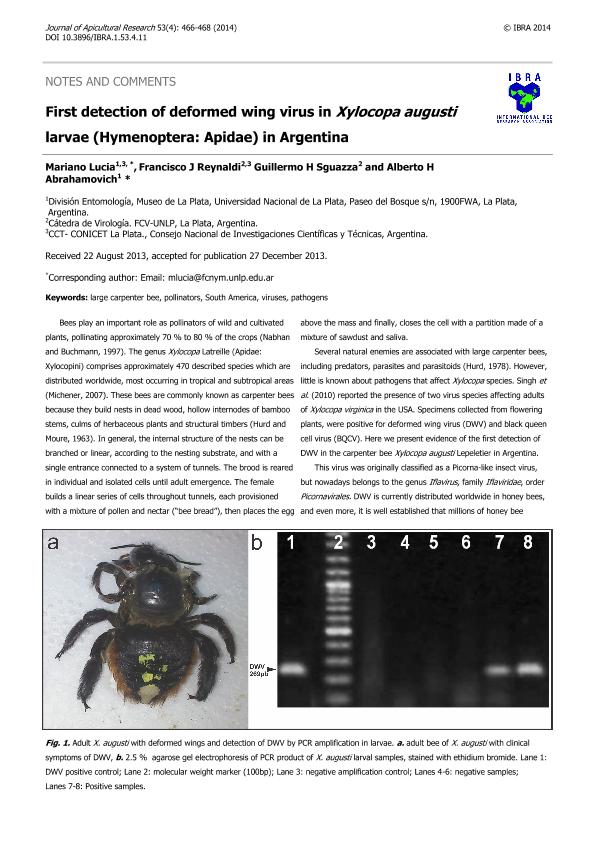Mostrar el registro sencillo del ítem
dc.contributor.author
Lucia, Mariano

dc.contributor.author
Reynaldi, Francisco José

dc.contributor.author
Sguazza, Guillermo Hernán

dc.contributor.author
Abrahamovich, Alberto Horacio

dc.date.available
2020-04-01T20:51:15Z
dc.date.issued
2014-02
dc.identifier.citation
Lucia, Mariano; Reynaldi, Francisco José; Sguazza, Guillermo Hernán; Abrahamovich, Alberto Horacio; First detection of Deformed wing virus DWV in Xylocopa augusti larvae (Hymenoptera: Apidae) in Argentina; International Bee Research Association; Journal Of Apicultural Research; 53; 4; 2-2014; 466-468
dc.identifier.issn
0021-8839
dc.identifier.uri
http://hdl.handle.net/11336/101582
dc.description.abstract
Bees play an important role as pollinators of wild and cultivated plants, pollinating approximately 70% to 80% of the crop (Nabhan and Buchmann, 1997). The genus Xylocopa Latreille (Apidae: Xylocopini) comprises approximately 470 described species and are distributed worldwide, most of them occurring in tropical and subtropical areas (Michener, 2007). These bees are commonly known as carpenter bees because they build nests in dead wood, hollow internodes of bamboo stems, culms of herbaceous plants and structural timbers (Hurd and Moure, 1963). In general, the internal structure of the nests can be branched or linear, according to the nesting substrate, and with a single entrance connected to a system of tunnels. The brood is reared in individual and isolated cells until adult emergence. The female builds a linear series of cells throughout tunnels, each provisioned with a mixture of pollen and nectar (?bee bread?), then places the egg above the mass and finally, closes the cell with a partition made of a mixture of sawdust and saliva. Several natural enemies are associated with large carpenter bees, including predators, parasites and parasitoids (Hurd, 1978). However, little is known about the pathogens that affect Xylocopa species; Singh et al. (2010) reported the presence of two virus species affecting adults of Xylocopa virginica in the USA, the specimens collected from flowering plants, were positive for Deformed wing virus (DWV) and Black queen cell virus (BQCV). Here we present evidence of the first detection of DWV in the carpenter bee Xylocopa augusti Lepeletier in Argentina.
dc.format
application/pdf
dc.language.iso
eng
dc.publisher
International Bee Research Association

dc.rights
info:eu-repo/semantics/openAccess
dc.rights.uri
https://creativecommons.org/licenses/by-nc-sa/2.5/ar/
dc.subject
Large carpenter bee
dc.subject
Pollinators
dc.subject
South America
dc.subject
Viruses
dc.subject
Pathogens
dc.subject.classification
Zoología, Ornitología, Entomología, Etología

dc.subject.classification
Ciencias Biológicas

dc.subject.classification
CIENCIAS NATURALES Y EXACTAS

dc.title
First detection of Deformed wing virus DWV in Xylocopa augusti larvae (Hymenoptera: Apidae) in Argentina
dc.type
info:eu-repo/semantics/article
dc.type
info:ar-repo/semantics/artículo
dc.type
info:eu-repo/semantics/publishedVersion
dc.date.updated
2020-03-30T16:22:39Z
dc.journal.volume
53
dc.journal.number
4
dc.journal.pagination
466-468
dc.journal.pais
Reino Unido

dc.description.fil
Fil: Lucia, Mariano. Consejo Nacional de Investigaciones Científicas y Técnicas. Centro Científico Tecnológico Conicet - La Plata; Argentina. Universidad Nacional de La Plata. Facultad de Ciencias Naturales y Museo. Departamento Científico de Entomología; Argentina
dc.description.fil
Fil: Reynaldi, Francisco José. Universidad Nacional de La Plata. Facultad de Ciencias Veterinarias. Departamento de Microbiología. Cátedra de Virología; Argentina. Consejo Nacional de Investigaciones Científicas y Técnicas. Centro Científico Tecnológico Conicet - La Plata; Argentina
dc.description.fil
Fil: Sguazza, Guillermo Hernán. Universidad Nacional de La Plata. Facultad de Ciencias Veterinarias. Departamento de Microbiología. Cátedra de Virología; Argentina
dc.description.fil
Fil: Abrahamovich, Alberto Horacio. Universidad Nacional de La Plata. Facultad de Ciencias Naturales y Museo. Departamento Científico de Entomología; Argentina. Consejo Nacional de Investigaciones Científicas y Técnicas. Centro Científico Tecnológico Conicet - La Plata; Argentina
dc.journal.title
Journal Of Apicultural Research

dc.relation.alternativeid
info:eu-repo/semantics/altIdentifier/doi/http://dx.doi.org/10.3896/IBRA.1.53.4.11
dc.relation.alternativeid
info:eu-repo/semantics/altIdentifier/url/https://www.tandfonline.com/doi/abs/10.3896/IBRA.1.53.4.11
Archivos asociados
